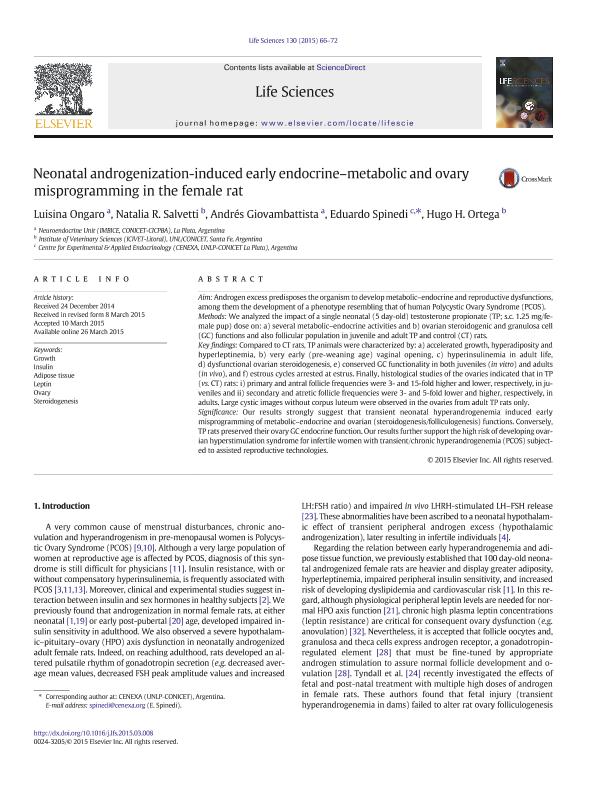Artículo
Neonatal androgenization-induced early endocrine–metabolic and ovary misprogramming in the female rat
Ongaro Gambino, Luisina ; Salvetti, Natalia Raquel
; Salvetti, Natalia Raquel ; Giovambattista, Andres
; Giovambattista, Andres ; Spinedi, Eduardo Julio
; Spinedi, Eduardo Julio ; Ortega, Hugo Hector
; Ortega, Hugo Hector
 ; Salvetti, Natalia Raquel
; Salvetti, Natalia Raquel ; Giovambattista, Andres
; Giovambattista, Andres ; Spinedi, Eduardo Julio
; Spinedi, Eduardo Julio ; Ortega, Hugo Hector
; Ortega, Hugo Hector
Fecha de publicación:
06/2015
Editorial:
Pergamon-elsevier Science Ltd
Revista:
Life Sciences
ISSN:
0024-3205
Idioma:
Inglés
Tipo de recurso:
Artículo publicado
Clasificación temática:
Resumen
Aim: Androgen excess predisposes the organism to develop metabolic–endocrine and reproductive dysfunctions, among them the development of a phenotype resembling that of human Polycystic Ovary Syndrome (PCOS).
Methods: We analyzed the impact of a single neonatal (5 day-old) testosterone propionate (TP; s.c. 1.25 mg/female pup) dose on: a) several metabolic–endocrine activities and b) ovarian steroidogenic and granulosa cell (GC) functions and also follicular population in juvenile and adult TP and control (CT) rats.
Key findings: Compared to CT rats, TP animals were characterized by: a) accelerated growth, hyperadiposity and hyperleptinemia, b) very early (pre-weaning age) vaginal opening, c) hyperinsulinemia in adult life, d) dysfunctional ovarian steroidogenesis, e) conserved GC functionality in both juveniles (in vitro) and adults (in vivo), and f) estrous cycles arrested at estrus. Finally, histological studies of the ovaries indicated that in TP (vs. CT) rats: i) primary and antral follicle frequencies were 3- and 15-fold higher and lower, respectively, in juveniles and ii) secondary and atretic follicle frequencies were 3- and 5-fold lower and higher, respectively, in adults. Large cystic images without corpus luteum were observed in the ovaries from adult TP rats only.
Significance: Our results strongly suggest that transient neonatal hyperandrogenemia induced early misprogramming of metabolic–endocrine and ovarian (steroidogenesis/folliculogenesis) functions. Conversely, TP rats preserved their ovary GC endocrine function. Our results further support the high risk of developing ovarian hyperstimulation syndrome for infertile women with transient/chronic hyperandrogenemia (PCOS) subjected to assisted reproductive technologies.
Palabras clave:
Adipose Tissue
,
Growth
,
Insulin
,
Leptin
,
Ovary
,
Steroidogenesis
Archivos asociados
Licencia
Identificadores
Colecciones
Articulos(CENEXA)
Articulos de CENTRO DE ENDOCRINOLOGIA EXP.Y APLICADA (I)
Articulos de CENTRO DE ENDOCRINOLOGIA EXP.Y APLICADA (I)
Articulos(ICIVET-LITORAL)
Articulos de INST. DE CIENCIAS VETERINARIAS DEL LITORAL
Articulos de INST. DE CIENCIAS VETERINARIAS DEL LITORAL
Articulos(IMBICE)
Articulos de INST.MULTIDISCIPL.DE BIOLOGIA CELULAR (I)
Articulos de INST.MULTIDISCIPL.DE BIOLOGIA CELULAR (I)
Citación
Ongaro Gambino, Luisina; Salvetti, Natalia Raquel; Giovambattista, Andres; Spinedi, Eduardo Julio; Ortega, Hugo Hector; Neonatal androgenization-induced early endocrine–metabolic and ovary misprogramming in the female rat; Pergamon-elsevier Science Ltd; Life Sciences; 130; 6-2015; 66-72
Compartir
Altmétricas



